Tours in Bhutan
Tours in Bhutan
About the Tours in Bhutan
A selection of our tours is listed below. We have another fifteen-odd more tours ready and all of them can be tailored to your interests. Right now, we’re focusing on developing new tours, treks and walking (hiking) tours, as well as wildlife and birding tours in South-Bhutan (winter & spring season). We feel walking is still the best way to discover the authentic parts of a country like Bhutan.
The treks and walking (hiking) tours can be tailored to your wishes, ranging form walking a few hours every other day, to doing strenuous walks almost daily. On these tours, you’ll be traveling by car and sleeping in decent hotels and clean home stays. Adding a two- or three-day trek is highly recommended. That is, if you are comfortable with the idea of sleeping one or two nights in a tent.
Three of the walking (hiking) tours are listed below. These are ideal for those who appreciate the extras of places beyond the tarmac, but don’t want to spend the major part of their tour in one area (which is the case on medium-distance treks. We’ll soon have walking alternatives for most of the popular general tours. Please drop us a line if you have special wishes.
A trip to Bhutan would not be complete without a visit to one of the many Buddhist festivals that are being held throughout the country. Tsechu means tenth day in the Dzongkha, the national language of Bhutan. Every tenth day of the month is considered a prosperous day and most festivals in Bhutan are held on this day. The most important historical figure honored on the tsechus is Guru Rimpoche (also called Padmasambhava), a buddhist apostle who is credited with introducing Buddhism to Bhutan in the 8th century. It is a special experience in itself to attend the mask dances, but even more so to see how the Bhutanese people stick to their religion and culture and derive a lot of happiness from it. You’ll find a list of the festivals at the bottom of this page.
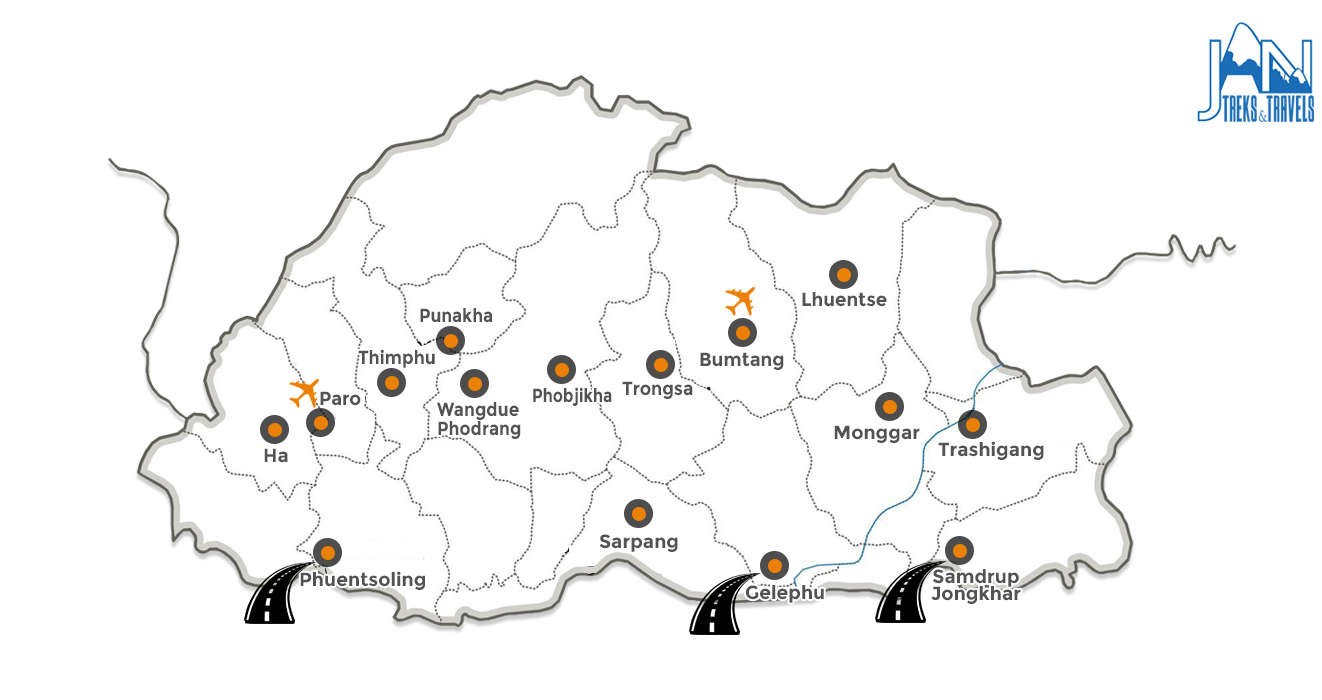
Jeep Tours
Treks
10-day trek with visit Bumthang & Phobjikha - 14 days
Medium-serious trek (Nov - Dec & March- April)
Walking / Hiking Tours
Wildlife & Birding Tours
ABOUT Bhutan
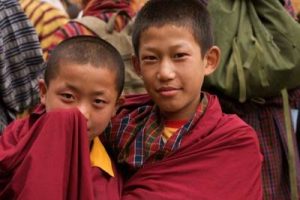 Imagine a small country the size of the Netherlands, a country labeled the hidden kingdom, a true Shangrila, and the mystic land of Buddhist saints. Bhutan is definitely not your average holiday destination. It is the only one of the former Himalaya Kingdoms that has managed to retain its independence, as well as its unique culture and nature. It is the only country in the world where the vast majority adheres to Mahayana (‘Tibetan’) Buddhism, as well as this being the state religion. Dress, etiquette and arts have their own Bhutanese style which goes back to the sixteenth century. But don’t expect a museum: Bhutan is welcoming and enchanting, yet alive and vibrant. The Bhutanese are kind-hearted, sincere and surprisingly professional.
Imagine a small country the size of the Netherlands, a country labeled the hidden kingdom, a true Shangrila, and the mystic land of Buddhist saints. Bhutan is definitely not your average holiday destination. It is the only one of the former Himalaya Kingdoms that has managed to retain its independence, as well as its unique culture and nature. It is the only country in the world where the vast majority adheres to Mahayana (‘Tibetan’) Buddhism, as well as this being the state religion. Dress, etiquette and arts have their own Bhutanese style which goes back to the sixteenth century. But don’t expect a museum: Bhutan is welcoming and enchanting, yet alive and vibrant. The Bhutanese are kind-hearted, sincere and surprisingly professional.
Bhutan’s far-sighted rulers choose to let the 21st century in only as much as deemed necessary to enhance Gross National Happiness. The erstwhile king has coined this term in 1972, and declared it more important than Gross National Product. Buddhist faith, as well as a widely shared common sense that places well-being above wealth, is at the base of this remarkable attitude. Since then it has become the lead motif for government policies, and even an export article as more and more countries are considering incorporating GNP in their development strategy. Traveling around Bhutan one can’t deny that happiness seems to be much more in supply here than elsewhere.
RICH IN OTHER WAYS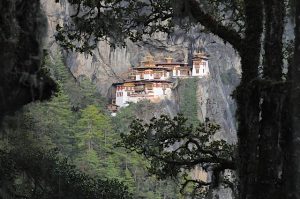 The Bhutanese form of restrained development doesn’t imply that the Bhutanese are poor. The average income stands comparison with many developed country. Compared to its neighboring countries, the Bhutanese definitely stand out in terms of sustainable assets. Thanks to its low population density and its well-preserved natural resources most families own a sizable farm with sufficient farmland, forest and animals to ensure them and their children a good living. Money coming in from the sale of hydro-electricity to India and from tourism is spent on education, health care, nature conservation and the general ‘cultural maintenance’ of the country. Natural beauty is Bhutan’s second asset. Apart from glaciated Himalaya peaks and crystal clear streams Bhutan is covered with dense primary forests. Woodlands cover 66% of the national area and it is official government policy not to let it drop below this amazing figure, the highest in Asia.
The Bhutanese form of restrained development doesn’t imply that the Bhutanese are poor. The average income stands comparison with many developed country. Compared to its neighboring countries, the Bhutanese definitely stand out in terms of sustainable assets. Thanks to its low population density and its well-preserved natural resources most families own a sizable farm with sufficient farmland, forest and animals to ensure them and their children a good living. Money coming in from the sale of hydro-electricity to India and from tourism is spent on education, health care, nature conservation and the general ‘cultural maintenance’ of the country. Natural beauty is Bhutan’s second asset. Apart from glaciated Himalaya peaks and crystal clear streams Bhutan is covered with dense primary forests. Woodlands cover 66% of the national area and it is official government policy not to let it drop below this amazing figure, the highest in Asia.
Tourism is managed in such a way that the negative side-effects which are all too obvious in other Asian countries, such as pollution, deforestation, over-use of local resources and loss of cultural identity, are prevented. The trick is simple but effective: foreigners pay a fixed amount per day for visiting the country, regardless of the itinerary and program of their journey. It ensures a steady flow of dollars and prevents mass tourism. At present the tariff is 200 USD per day during the winter months of December, January and February, as well as the monsoon months of June and July, and 250 USD per day for all other months of the year.
ROYAL CRAZE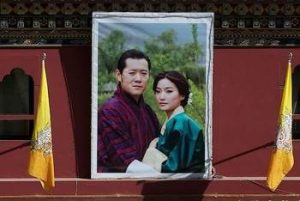 Bhutan can be traveled by road or on foot. Both will reward you with encounters with utterly friendly people, their unique Buddhist culture and some of the last untouched mountains of the Himalayas. But only trekkers get to see the magnificent peaks and glaciers of the Himalayan Range up-close, as well as some isolated hamlets where time literally seems arrested.
Bhutan can be traveled by road or on foot. Both will reward you with encounters with utterly friendly people, their unique Buddhist culture and some of the last untouched mountains of the Himalayas. But only trekkers get to see the magnificent peaks and glaciers of the Himalayan Range up-close, as well as some isolated hamlets where time literally seems arrested.
The young and enterprising king of Bhutan, Jigme Khesar Namgyal Wangchuk, understands this too, and in order to know what’s going on in his kingdom, he vowed to visit each and every household in the next years. For that he needs to set out on treks over winding mountain trails, eating the simple local food (which he often prepares himself, it is said) and staying in local farm houses. It is just one of the reasons that the Bhutanese love and revere their king. When he recently married the strikingly beautiful Jetsun Pema Wangchuk, the whole nation was either present or glued to the nearest television set. Being 39 and 29 years old, they’re the youngest royal couple in the world. Gesar’s father, Jigme Singye Wangchuk was, and still is, possibly even more popular. He more or less single-handedly led Bhutan from a ‘medieval’ kingdom to a modern democracy. He is also one of the major driving forces behind Bhutan’s unique development model, coining the term Gross National Happiness as early as in 1972.
GETTING TO BHUTAN
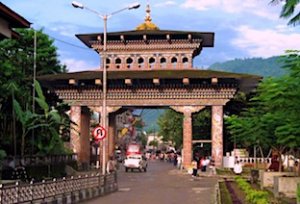 For most visitors – mind you the word tourist is not used in Bhutan – Paro Int. Airport is the place to fly in and out of Bhutan. As Paro is situated in the west of Bhutan this implies for most that they don’t get to see the lower lying southern parts of Bhutan, nor the eastern parts, as traveling there and backtracking to Paro would cost valuable days. But Bhutan can also be entered by road, at Phuentsoling in SW-Bhutan, at Gelephu in S-Central Bhutan or at Samdrup Jongkar in SE-Bhutan. Both entry points are on the border with Assam. As Samdrup Jongkar is just a couple of hours drive from Guwahati it is very well possible to start your Bhutan trip there.
For most visitors – mind you the word tourist is not used in Bhutan – Paro Int. Airport is the place to fly in and out of Bhutan. As Paro is situated in the west of Bhutan this implies for most that they don’t get to see the lower lying southern parts of Bhutan, nor the eastern parts, as traveling there and backtracking to Paro would cost valuable days. But Bhutan can also be entered by road, at Phuentsoling in SW-Bhutan, at Gelephu in S-Central Bhutan or at Samdrup Jongkar in SE-Bhutan. Both entry points are on the border with Assam. As Samdrup Jongkar is just a couple of hours drive from Guwahati it is very well possible to start your Bhutan trip there.
Of course you can go straight for the jungle-covered hills of Bhutan. Or you can first spend some time in Assam and savor some of the best wild life parks in the world – see our tours in NE-India – and maybe also cruise the Brahmaputra for a few days to fully unwind from your hectic working existence.
Festivals in Bhutan 2025
| Date | Festival | Place |
|---|---|---|
| 6th – 8th March | Punakha Dzong, Punakha | Punakha Drubchen |
| 9th – 11th March | Punakha Dzong, Punakha | Punakha Tshechu |
| 14th March | Tharpaling Lhakhang, Chumi, Bumthang | Tharpaling Thongdrol |
| 15th-17th March | Tangsibi Lhakhang, Ura Bumthang | Tangsibi Mani |
| 14th March & 29th March | Chorten Kora, Trashiyangtshe | Chhorten Kora |
| 5th- 7th April | Gom Kora Lhakhang, Trashigang | Gomphukora |
| 5th- 7th April | Talo Gonpa, Punakha | Talo Tshechu |
| 5th- 7th April | Gasa Dzong, Gasa | Gasa Tshechu |
| 5th- 7th April | Zhemgang Dzong, Zhemgang | Zhemgang Tshechu |
| 8th-12th April Thongdral on last day | Rinpung Dzong, Paro | Paro Tshechu |
| 22nd – 24th April | Lamperi Botanical Park, Thimphu | Rhododendron Festival |
| 7th-9th May | Domkhar, Chumi, Bumthang. | Domkhar Tshechu |
| 9th-13th May | Ura Lhakhang, Bumthang | Ura Yakchoe |
| 3rd-5th July | Nimalung Dratshang, Chumi, Bumthang | Nimalung Tshechu |
| 5th July | Kurjey Lhakhang, Choekhor, Bumthang | Kurjey Tshechu |
| 6th September | Bumthang to Thimphu | Tour of the Dragon Mountain Bike Race |
| 28th September | Tashi Chhodzong, Thimphu | Thimphu Drubchen |
| 30th September 1st-2nd October | Wangduephodrang | Wangdue Tshechu |
| 2nd – 4th October | Tamshing lhakhang, Bumthang | Tamshing Phala Chhoepa |
| 2nd – 4th October | Tashi Chhodzong, Thimphu | Thimphu Tshechu |
| 5th-7th October Thongdral on last day | Gangtey Gonpa, Wangduephodrang | Gangtey Tshechu |
| 7th-8th October | Tangbi Lhakhang, Choekor, Bumthang | Thangbi Mewang |
| 14th-15th October | Dangochong, Thimphu | Jhomolhari Mountain Festival |
| 29th to 31st October | Chhukha Dzong, Chhukha | Chhukha Tshechu |
| 29th-31st October 1st october | Jakar Dzong, Choekhor, Bumthang. | Jakar Tshechu |
| 29th-31st october 1st october Thongdrel on last day | Pemagatshel Dzong, Pemagatshel. | Pemagatshel Tshechu |
| 31st October | Dechenphu Lhakhang, Thimphu | Dechenphu Tshechu |
| 5th-8th November | Jambay Lhakhang, Choekhor, Bumthang | Jambay Lhakhang Drup |
| 6th- 8th November | Prakar Khakhang, Chumni, Bumthang | Prakhar Duchhoed |
| 11th November | Gangtey Gonpa, Phobjikha, Wangduephodrang. | Black Necked Crane Festival |
| 28th-30th November | Mongar Dzong, Mongar | Mongar Tshechu |
| 29th-30th November 1stDecember | Trashigang Dzong, Trashigang. | Trashigang Tshechu |
| 28th-30th November | Phuntsholing, Chhukha | Phuntsholing Tsechu |
| 4th December | Jambay Lhakhang, Choekhor, Bumthang | Jambay Lhakhang Singye Cham |
| 4th – 6th December | Ngaa Lhakhang, Choekhor, Bumthang | Nalakhar Tshechu |
| 13th Dec | Douchula , Thimphu | Druk Wangyel Tshechu |
| 27th – 31st December Thongdral on last day | Trongsa Dzong, Trongsa | Trongsa Tshechu |
| 27th – 31st December Thongdral on last day | Lhuentse Dzong, Lhuentse | Lhuentse Tshechu |
| 3rd-5th Jan 2026 | Nabji Lhakhang, Nabji, Trongsa | Nabji Lhakhang Drup |
| 1st-3rd Jan, 2026 | Samdrupjongkhar | Samdrupjongkhar Tshechu |



